Articles
- Page Path
- HOME > J Korean Acad Nurs > Volume 40(6); 2010 > Article
-
Original Article
- Correlation between Subjective and Objective Measurement of Climacteric Women's Hot Flashes
- Hyung-Jun Kim, Kang-Hyun Leem, Myoung-Hee Kim
-
Journal of Korean Academy of Nursing 2010;40(6):765-774.
DOI: https://doi.org/10.4040/jkan.2010.40.6.765
Published online: December 31, 2010
1Associate Professor, College of Korean Medicine, Semyung University, Jecheon, Korea.
2Associate Professor, Department of Nursing, Semyung University, Jecheon, Korea.
- Address reprint requests to: Kim, Myoung-Hee. Department of Nursing, Semyung University, 579 Sinwol-dong, Jecheon 390-711, Korea. Tel: 82-43-649-1352, Fax: 82-43-649-1785, mh1352@semyung.ac.kr
Copyright © 2010 Korean Society of Nursing Science
Abstract
-
Purpose
- The purposes of this study were to explain the phenomena of hot flashes in climacteric women by using Mexameter, Skin Thermometer, Corneometer, and Laser Doppler Perfusion Imager (LDPI) objectively and to identify the interrelation between the subjective and objective measurements of hot flashes by comparing the two as reported in retrospective questionnaires.
-
Methods
- The participants were one hundred women (45-60 yr) who were not currently on hormone therapy, and had reached hot flash scores of 10 or higher. Hot flashes were measured in a temperature and humidity controlled room for 7 hr from 10 am to 5 pm. Hot flashes were measured subjectively and recorded via the Hot Flash Diary Report. When participants felt the hot flashes, they were measured objectively by Mexameter, Skin Thermometer, Corneometer, and LDPI.
-
Results
- The frequency of hot flashes in participants ranged from 1 to 7 times. When hot flashes occurred in participants, the erythema, skin temperature, skin hydration, and blood perfusion showed statistically significant changes in all measurements. But, the subjective and objective measurements of hot flashes showed only weak correlations.
-
Conclusion
- Results indicate a need for future research with subjective and objective measuring instruments chosen depending variations identified for the study.
This study was supported by a grant of the Korea Healthcare Technology R&D Project, Ministry for Health, Welfare & Family Affairs, Republic of Korea (B08-0042).
- 1. Carpenter JS, Azzouz F, Monahan PO, Storniolo AM, Ridner SH. Is sternal skin conductance monitoring a valid measure of hot flash intensity or distress? Menopause. 2005;12:512–519.ArticlePubMed
- 2. Carpenter JS, Monahan PO, Azzouz F. Accuracy of subjective hot flush reports compared with continuous sternal skin conductance monitoring. Obstetrics and Gynecology. 2004;104:1322–1326.ArticlePubMed
- 3. Dormire SL. What we know about managing menopausal hot flashes: Navigating without a compass. Journal of Obstetric, Gynecologic, and Neonatal Nursing. 2003;32:455–464.Article
- 4. Faure ED, Chantre P, Mares P. Effects of a standardized soy extract on hot flushes: A multicenter, double-blind, randomized, placebo-controlled study. Menopause. 2002;9:329–334.ArticlePubMed
- 5. Guthrie JR, Dennerstein L, Taffe JR, Donnelly V. Health care-seeking for menopausal problems. Climacteric. 2003;6:112–117.ArticlePubMed
- 6. Han KK, Soares JM Jr, Haidar MA, de Lima GR, Baracat EC. Benefits of soy isoflavone therapeutic regimen on menopausal symptoms. Obstetrics and Gynecology. 2002;99:389–394.ArticlePubMed
- 7. Kim KH, Kang KW, Kim DI, Kim HJ, Yoon HM, Lee JM, et al. Effects of acupuncture on hot flashes in perimenopausal and postmenopausal women: A multicenter randomized clinical trial. Menopause. 2010;17:269–280.ArticlePubMed
- 8. Kim MJ, Kim JH. How long do menopausal hot flushes really last? Journal of Korean Society of Menopause. 2009;15:73–78.
- 9. Lee JY. Hot flashes. Journal of Korean Society of Menopause. 2004;10:3–9.
- 10. Manson JE, Hsia J, Johnson KC, Rossouw JE, Assaf AR, Lasser NL, et al. Estrogen plus progestin and the risk of coronary heart disease. The New England Journal of Medicine. 2003;349:523–534.ArticlePubMed
- 11. Miller HG, Li RM. Measuring hot flashes: Summary of a National Institutes of Health workshop. Mayo Clinic Proceedings. 2004;79:777–781.ArticlePubMed
- 12. Nachtigall LE, Baber RJ, Barentsen R, Durand N, Panay N, Pitkin J, et al. Complementary and hormonal therapy for vasomotor symptom relief: A conservative clinical approach. Journal of Obstetrics and Gynaecology Canada. 2006;28:279–289.ArticlePubMed
- 13. North American Menopause Society. Treatment of menopause-associated vasomotor symptoms: Position statement of the North American Menopause Society. Menopause. 2004;11:11–33.PubMed
- 14. Obermeyer CM. Menopause across cultures: A review of the evidence. Menopause. 2000;7:184–192.Article
- 15. Otte JL, Flockhart D, Hayes D, Storniolo AM, Stearns V, Schneider B, et al. Comparison of subjective and objective hot flash measures over time among breast cancer survivors initiating aromatase inhibitor therapy. Menopause. 2009;16:653–659.ArticlePubMedPMC
- 16. Sievert LL, Begum K, Sharmeen T, Chowdhury O, Muttukrishna S, Bentley G. Patterns of occurrence and concordance between subjective and objective hot flashes among muslim and hindu women in sylhet, bangladesh. American Journal of Human Biology. 2008;20:598–604.ArticlePubMed
- 17. Sloan JA, Loprinzi CL, Novotny PJ, Barton DL, Lavasseur BI, Windschitl H. Methodologic lessons learned from hot flash studies. Journal of Clinical Oncology. 2001;19:4280–4290.ArticlePubMed
- 18. Stearns V, Hayes DF. Approach to menopausal symptoms in women with breast cancer. Current Treatment Options in Oncology. 2002;3:179–190.ArticlePubMedPDF
- 19. Thurston RC, Blumenthal JA, Babyak MA, Sherwood A. Emotional antecedents of hot flashes during daily life. Psychosomatic Medicine. 2005;67:137–146.ArticlePubMed
- 20. Thurston RC, Blumenthal JA, Babyak MA, Sherwood A. Association between hot flashes, sleep complaints, and psychological functioning among healthy menopausal women. International Journal of Behavioral Medicine. 2006;13:163–172.ArticlePubMed
- 21. Tice JA, Ettinger B, Ensrud K, Wallace R, Blackwell T, Cummings SR. Phytoestrogen supplements for the treatment of hot flashes: The isoflavone clover extract (ICE) study: A randomized controlled trial. JAMA: Journal of the American Medical Association. 2003;290:207–214.
- 22. Utian WH. Psychosocial and socioeconomic burden of vasomotor symptoms in menopause: A comprehensive review. Health and Quality of Life outcomes. 2005;3:47–57.PubMedPMC
- 23. Yu HK. Hot flashes and sweating: Pathology, diagnosis, and treatment. Journal of Korean Society of Menopause. 1996;2:132–146.
REFERENCES
Figure & Data
REFERENCES
Citations

- Ectopic Mediastinal Thyroid: A Crossroad Between a Multi-Layered Endocrine Perspective and a Contemporary Approach in Thoracic Surgery
Claudiu Nistor, Mihai-Lucian Ciobica, Oana-Claudia Sima, Anca-Pati Cucu, Florina Vasilescu, Lucian-George Eftimie, Dana Terzea, Mihai Costachescu, Adrian Ciuche, Mara Carsote
Life.2024; 14(11): 1374. CrossRef - Acupuncture for the Treatment of Hot Flashes in Patients with Breast Cancer Receiving Antiestrogen Therapy: A Pilot Study in Korean Women
Young Ju Jeong, Young Sun Park, Hyo Jung Kwon, Im Hee Shin, Jin Gu Bong, Sung Hwan Park
The Journal of Alternative and Complementary Medicine.2013; 19(8): 690. CrossRef - Effects of Origanum Majorana Essential Oil Aroma on the Electroencephalograms of Female Young Adults with Sleep Disorders
Han-Na Jung, Hyun-Ju Choi
Journal of Life Science.2012; 22(8): 1077. CrossRef
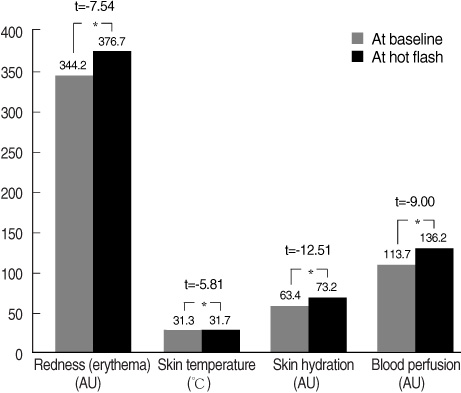
Figure 1
General Characteristics of Participants (N=100)
BMI=body mass index.
The Frequency of Hot Flashes of Participants (N=100)
*Measure in a temperature and humidity-controlled laboratory room for 7 hours from 10 am to 5 pm.
Descriptive Statistics of Subjective and Objective Measures (N=100)
*Visual Analogue Scale; †Retrospective measure; ‡Measure in a temperature and humidity-controlled laboratory room; §Arbitrary unit.
The Correlations between Subjective Measures and Objective Measures (N=100)
VAS=Visual analogue scale.
BMI=body mass index.
*Measure in a temperature and humidity-controlled laboratory room for 7 hours from 10 am to 5 pm.
*Visual Analogue Scale; †Retrospective measure; ‡Measure in a temperature and humidity-controlled laboratory room; §Arbitrary unit.
VAS=Visual analogue scale.
 KSNS
KSNS
 E-SUBMISSION
E-SUBMISSION

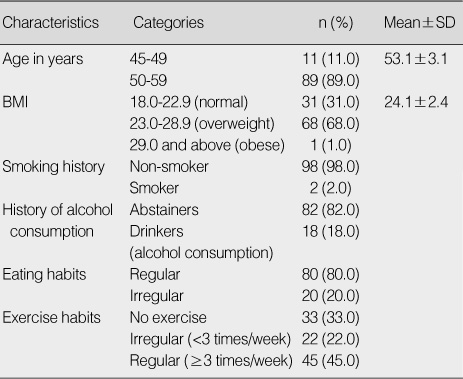
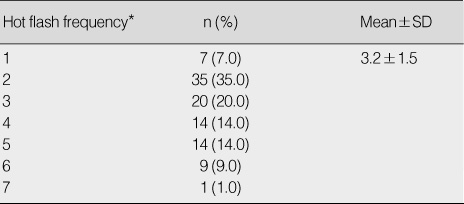
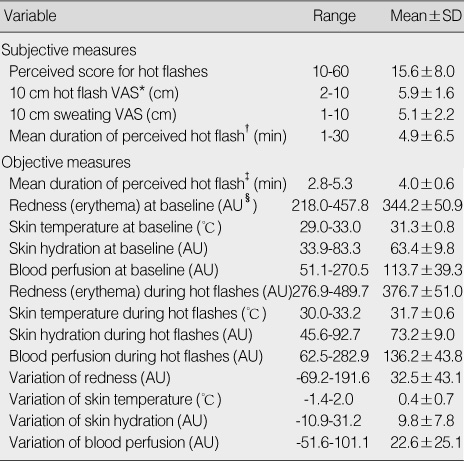
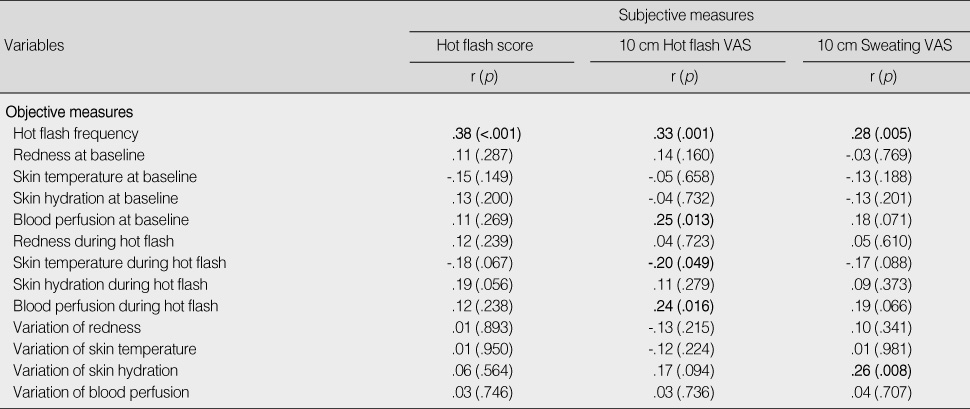
 Cite
Cite

